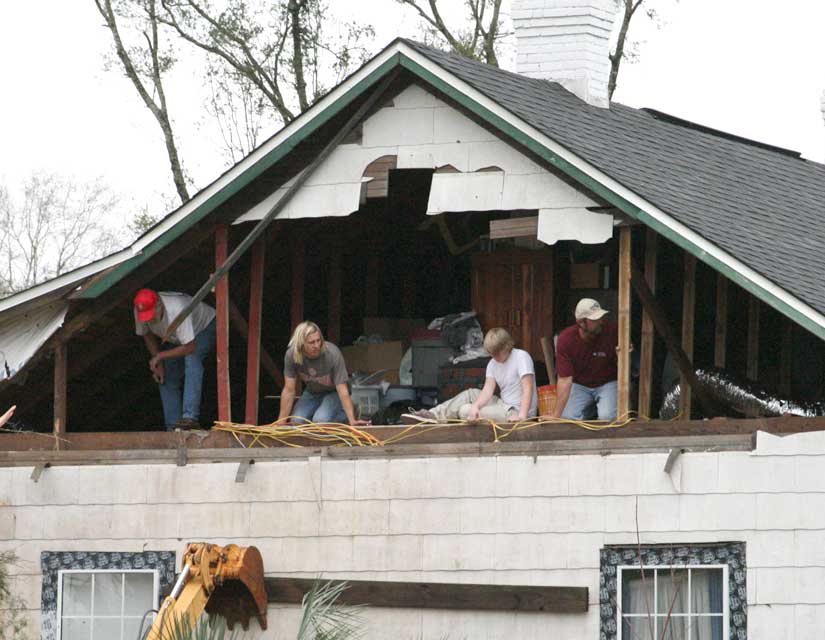After The Storm: Information, Phone Numbers You Need To Know
February 19, 2008
After a storm like the apparent tornado in Molino Sunday, there are important next steps for those that have damage.
NorthEscambia.com has tips residents and business owners below. At the bottom of this page, you will find a list of important phone numbers to know.
Your Need To Know: Making The Claim
Contact your insurance agent as quickly as possible. Let them know about your losses. If you are relocated temporarily, provide the address and phone number. The claim process may begin in one of two ways. Your insurance company may send a claim form for you to complete or an adjuster may visit your home first, before you are asked to fill out any forms.
Most homeowners policies cover additional living expenses. Your insurance company should advance you money if you need temporary shelter, food and clothing because you can no longer live in your home and your clothes have been ruined. They will also advance you money if you need to replace major household items immediately to continue living there.
Keep receipts for everything you spend. Make sure the check for additional living expenses is made out to you and not your mortgage, the bank or other lender. This money has nothing to do with repairs to your home and you may have difficulty depositing or cashing the check without their signature.
Make only those repairs necessary to prevent further damage to your home or business. This must include covering breaks or holes in the roof, walls or windows with plywood, canvas or other waterproof material. Your insurance company will reimburse you for the costs of your repairs, so keep receipts for any materials you buy. Do not have permanent repairs made without first consulting your agent. Unauthorized repairs may not be reimbursed.
Avoid using electrical appliances, including televisions and stereos, which have been exposed to water, unless a technician has checked them.
If your car was damaged and you have “comprehensive” coverage in your auto insurance policy, you should also contact your auto insurance company.
Make as many photographs as possible of damage for documentation.
Your Need To Know: Preparing For The Adjuster’s Visit
An adjuster is a person professionally trained to assess the damage. The more information you have about your possessions the faster your claim can be settled. You should already have a complete inventory of the items in your home that includes a description of the item, model and serial numbers (if applicable) and the original cost and what it would cost to replace it.
Make a list of damaged items. Take photographs of the damage and put together a set of records for each item that includes any old receipts or bills. Don’t forget to list items such as clothing, sports equipment, tools, china and linens, etc.
Don’t throw away damaged furniture or other items because the adjuster will want to see them.
Identify the structural damage to your home and other buildings on your premises. Make a list of everything you want to show the adjuster when they arrive. In some cases, the adjuster may recommend hiring a licensed engineer or architect to inspect the property. You should also get the electrical system checked. Most insurance companies will pay for these inspections.
If possible, get written bids from reliable, licensed contractors on the repair work. This should make adjusting the claim faster and simpler.
Homeowners insurance policies usually don’t cover flood damage but they do cover other kinds of water damage. For example, they would generally pay for damage from rain coming through a hole in the roof or a broken window as long as the hole was caused by a hurricane or other disaster covered by the policy. You need a separate flood insurance policy to cover flood damage from any rising water. Contact your insurance agent regarding your coverage and the need for flood insurance.
If your home was severely damaged, you may have to rebuild sections in accordance with current building codes. In some cases, complying with the code may require a change in design or building materials and may cost more. Generally, homeowners insurance policies will not pay for these extra costs. Some insurance companies offer an endorsement that pays for a specified amount toward such changes.
Most insurance companies will pay for removal of trees that have fallen on your home but they will not pay to remove trees that have fallen and haven’t caused any damage to your home. Neither will they pay to replace trees or shrubbery that have been damaged by the storm.
Now is the time you should get an “insurance checkup”. Contact your insurance agent and make sure what your policy covers and doesn’t cover. After a disaster is not the time for surprises and finding out that you are not covered for losses.
Your Need To Know: Phone Numbers
- Emergencies: 911
- Gulf Power Company: 505-5711 or (800) 487-6937
- Frontier Communications: 611 or 587-5119 or (800) 476-4001 (611 will not reach Frontier from a cellular phone)
- Bright House Cable: (866) 876-1872
- Energy Services of Pensacola (ESP): 474-5300
- DirecTV: (800) 494-4388
- Dish Network: (888) 284-7116
- Escambia County Sheriff: 436-9630
- American Red Cross: 432-7601
- Salvation Army: 432-1501
- Florida Department of Insurance: 800-22-STORM
- Florida Department of Agriculture: 800-435-7352
- Attorney General (Consumer Fraud): 850-414-3600
- Crisis Counseling & Referral: 888-532-4006




Comments